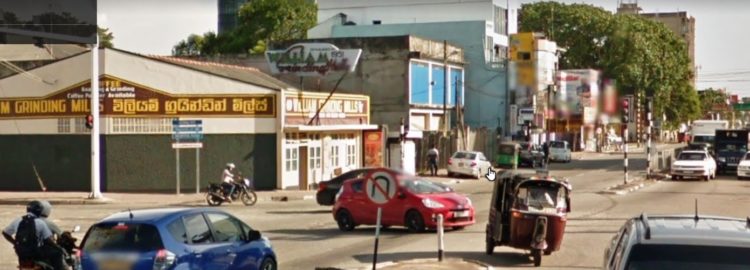 On 21st June 2018, William Grinding Mills finally put up shutters, grinding to a halt. Not only was it an iconic landmark, it was a true and trusted establishment patronised by everyone. Although located in Dehiwela (9A, Galle Road, Dehiwela), those living all over visited them to get their condiments pounded, ground, mixed or to buy their freshly prepared products. As a kid, I remember accompanying my mother there and, as a teenager, cycling from home with condiments to be ground and waiting until it was finished. It was always noisy and a bouquet of conflicting aromas assaulted you, as soon as you entered through the door. They also had a numbering system to make you wait your turn. It was not a fancy system like what you see today but it was effective and efficient. The impact of this establishment on our daily lives was cemented with the junction being named after it: the junction where Hospital Road met Galle Road. As kids, when we bought a bus ticket to get down near the bus-halt closest to the Grinding Mills, we simply said ‘William Grinding Mills’. That was enough. The bus driver and conductor knew exactly what we meant!
On 21st June 2018, William Grinding Mills finally put up shutters, grinding to a halt. Not only was it an iconic landmark, it was a true and trusted establishment patronised by everyone. Although located in Dehiwela (9A, Galle Road, Dehiwela), those living all over visited them to get their condiments pounded, ground, mixed or to buy their freshly prepared products. As a kid, I remember accompanying my mother there and, as a teenager, cycling from home with condiments to be ground and waiting until it was finished. It was always noisy and a bouquet of conflicting aromas assaulted you, as soon as you entered through the door. They also had a numbering system to make you wait your turn. It was not a fancy system like what you see today but it was effective and efficient. The impact of this establishment on our daily lives was cemented with the junction being named after it: the junction where Hospital Road met Galle Road. As kids, when we bought a bus ticket to get down near the bus-halt closest to the Grinding Mills, we simply said ‘William Grinding Mills’. That was enough. The bus driver and conductor knew exactly what we meant!
With the closure of this very iconic landmark another part of my childhood disappeared, and this prompted me to place on record, my memories of the Dehiwela, in which I grew up, from the late ‘60s to the late ‘80s ….
 Dehiwela is a hustling and bustling metropolis, ever changing and constantly attracting more and more inhabitants. The busiest road in the country, Galle Road runs through this city, the largest city next to Colombo. The Dehiwela in which I grew up was quite different to the present one. But some of its iconic landmarks exist, while others have faded away, but memories survive.
Dehiwela is a hustling and bustling metropolis, ever changing and constantly attracting more and more inhabitants. The busiest road in the country, Galle Road runs through this city, the largest city next to Colombo. The Dehiwela in which I grew up was quite different to the present one. But some of its iconic landmarks exist, while others have faded away, but memories survive.
“Thutthiri Watte / Thutthiri Pittaniya”
My parents bought their (first and only) house and we moved into Dehiwela, on 2nd August 1972. I was eight years old. Having lived in Colombo for two years, Dehiwela seemed a faraway place. Mind you, this was in spite of having lived the first five years of my life in Trincomalee. The move to Dehiwela, however, was a coming home for my grandmother (who lived with us) who was born and bred in Dehiwela.
Our house was on Quarry Road. It was not strictly situated on Quarry Road itself, but the address was “Quarry Road”. This became quite a problem when giving directions to visitors. It was off a small by-lane with no name. Today, it goes by the name Gal-Vihara Mawatha.(The name was suddenly there, but the name boards are no longer there!) To us ‘city folk’, this area was akin to a small village. On our side of the road, ours was the only house. The motorable gravel road came up to our gate only: after that one had to follow a footpath through the wilderness. All the other properties were empty and wild. This area was commonly known as ‘thutthiri watte’ and the empty land on to our left was known as ‘thutthiri pittaniya’. It was home to various wild beasts including snakes, polecats, mongoose and hare.
Although it resembled a small jungle, Thutthiri Pittaniya, played a variety of roles over the years. During the kite season, it was cleared so that it became our version of Galle Face. During school holidays, it became a cricket ground with several matches taking place simultaneously. It was the same during the soccer and rugby seasons. When allowed to grow back into a jungle, it played host to other sinister activities such as illegal gambling (booru pola), a brewery for “jungle juice” (aka kasippu), a hiding place for stolen goods, a place for illicit love affairs and once, even a mass-scale funeral!. Due to a tragedy which occurred at the canal bank (not 500 meters away), where a retaining wall collapsed and killed all inhabitants, the funeral was held under large tents, at Thutthiri Pittaniya. If memory serves me right, seven people perished during that tragedy. All of this, right next door to us !
Our nearest neighbours were a family who lived right across the gravel road from us. There were some other houses on that side of the road. This family and we became firm friends and that remains the same, even today. Their family consisted of one girl and two boys while ours consisted of one boy and one girl. The gravel road which ran between our houses was ideal in width for a badminton court. So we used to draw a net across the lane, mark the boundaries and play badminton quite often. As our lane only catered to foot traffic, we never had any problems. The gusts of wind which took our shuttlecock from its desired trajectory, somehow, never posed a problem. My sister and I practically lived in our neighbour’s house, often eating meals there.
A few houses away from ours, on the opposite side of the lane, lived a very enterprising couple. They hit upon a bright idea and converted their “ancestral” house into a ‘Club’. It was an interesting, novel and educating experience for us boys. The Club opened its doors for business every early evening with a band playing (quite loudly) while the patrons played cards and consumed large quantities of liquor and ‘bites’. To us, innocent ‘godayas’, this was something quite new. We used to hang on the half-wall which bordered the premises and watch, until our parents came and dragged us away, by our ears. To make matters even more interesting, the owners expanded their business activities and introduced “hostesses” who lived on the premises. In the evenings, these employees would cycle up and down the lane in various revealing attire. To say we came of age and became very worldly, long before we should have been, is an understatement!
To get to our nameless small lane, one had to turn off Allen Avenue into “Atapattu Pedesa” sandwiched between the Dehiwela Zoological Gardens (the Zoo) and the main water purification and distribution centre for the area. Commonly known as the ‘water tank’, it was fed from the waters of Kalatuwawa. Little did we realise that the main feeder line went right under our lane, until it started leaking from a broken gasket. As water seeped to the surface there was great delight in this new spring! Alas! We were soon disillusioned.
Since the zoo adjoined the road it was not unusual for us to see camels (single and double humped) and giraffes peering over the wall and looking at us, in quiet curiosity. From time to time (particularly after a heavy rain) parts of the retaining wall would collapse. Then we got an even better view. I remember seeing the zebra enclosure, quite clearly. Once, while I was walking early morning on my way to the bus stand, I heard a muffled ‘thud’ behind me. When I turned back and looked, part of the wall (where I have just walked by) had collapsed. The lion’s roar early in the morning was almost like an alarm call to us.
The old lady, her brood & inhabitants of the Zoo
I went to school in the Ananda College school bus. It was a double-decker which commenced its journey from the Ratmalana Depot, came up Hills Street, through Karagampitiya junction on to Allen Avenue. There were several of us who got into the bus from our unofficial bus stand, opposite the water tank. This was around 6:10am. We were at the bus stand much earlier and had a long jaw with the others until the bus arrived. Just by the spot where we waited for the bus, lived a small family comprising of an old grandmother and her two small granddaughters. Their home was a small wooden enclosure on wheels. It doubled as a small ‘petti-kade’ from which, the old woman sold various knick-knacks and food. Her clientele were those who visited the Zoo, daily. The whole structure was no more than 5ft x 4ft. And cramped at the best of times. Behind it was a makeshift area where they cooked and ate. The three slept inside the wooden shop. They had no pipe-borne water. The old lady used to walk across the road to the street water tap and collect water in vessels. I am not sure how often she did this each day. It must have been very hard work. She used to wake up the two grandkids and get them ready for school. There was an empty plot nearby which was their bathroom. I wonder what happened to them and their little petti-kade.
Another strange, and daily, event was the night-soil collectors. Most houses did not have cesspits and buckets were used to collect the waste matter. The Municipality had a set of workers (probably whose olfactory senses must have been kaput) who went around emptying these buckets into a trailer pulled by a tractor or into handcarts which were pushed. The handcarts went where a tractor could not go. We who were unfortunate to stand (waiting for the bus) early morning, smelt the tractor or handcart arrival long before it arrived and much longer after it passed our way. The pong, was terrible. Those poor Municipal Workers should have been given the Victoria Cross.
The inhabitants of the Zoo (the feathered kind) occasionally wandered (flew) off the reservation. While waiting for the school bus, I have seen an Ostrich, a Cassowary and an Emu being walked back by a Zoo worker firmly grasping its neck. While people came from far and wide to see exotic animals, we the lucky ones, saw them while waiting for the school bus! In later years, I was a member of the Young Zoologists’ Association (YZA) and had free access to the Zoo – even outside normal visiting hours. A privilege we highly valued. I have had the pleasure of petting and feeding a lion cub, a leopard cub and several otters. I will never trade those experiences for all the gold in the world.
Karagampitiya Sunday Pola
Every Sunday we visited the Sunday Pola at the Karagampitiya Junction. While there were about twenty permanent shops, on Sunday, the whole place came alive with vendors selling all manner of vegetables and fruits. The permanent shops were built, surrounding the Karagampitiya Bus Terminus, home to buses plying the 132, 118 and 176 routes. As the number of nomadic sellers increased, they set up stalls along Allen Avenue and sometimes, as far as the Central School, near the water tank. There were no pavements. So road traffic moved at a snail’s pace. But no one complained. It was a way of life and life itself was not fast paced.
Adding colour to the vegetable and fruit vendors, there were various ‘vedha mahatthayas’ selling a fascinating array of magic cures for every ailment from the common cold to cancer. Some of them even had live reptiles on display as a marketing aid. I used to love watching them in action and listen to their tall stories. As an impressionable boy, I must admit, I believed in some of their stories.
I still remember listening to one vendor displaying a bottle of capsules (black and orange) and being told that it would cure all manner of ailments. He told us that the main ingredient was a dust brought from the moon. He called this magic ‘karal’ Beeoliyo. Later that day, when I told my father about this magic cure – making a case for buying some – he roared with laughter and told me, that those pills were Vitamin-B capsules ! What can I say? ….. I was young.
Wally’s Studio and the YMBA barber shop
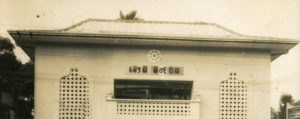 Wally’s Studio (still in existence) was where we went, when we had to have our photographs taken. There were no instant picture booths in that era. When I had to sit for my Ordinary Level Examination, it was to Wally’s that I went, to get my mug-shot for the Postal ID Card. I still have it with me. The quality of the picture is still the same. Opposite Wally’s, on the sea-side was the Dehiwela YMBA (also still in existence). This was the home of the Registrar of Marriages, where my paternal grandparents had registered their marriage. It was also where one of my aunts (mother’s sisters) registered her marriage, too.
Wally’s Studio (still in existence) was where we went, when we had to have our photographs taken. There were no instant picture booths in that era. When I had to sit for my Ordinary Level Examination, it was to Wally’s that I went, to get my mug-shot for the Postal ID Card. I still have it with me. The quality of the picture is still the same. Opposite Wally’s, on the sea-side was the Dehiwela YMBA (also still in existence). This was the home of the Registrar of Marriages, where my paternal grandparents had registered their marriage. It was also where one of my aunts (mother’s sisters) registered her marriage, too.
Down below in the basement, there was an old fashioned barber shop (not to be confused with “Salons” of today). This is where my friends, schoolmates from Dehiwela, and I went for our regular haircuts. There was no calling ahead and getting an appointment. You just turned up and waited for your turn. It was on a ‘first come, first served’ basis. It was a fascinating place for a young boy with a curious mind. The chairs were comfortable and the backs could be tilted (for shaving) by removing a peg (at the back) and adjusting the backrest. These chairs did not have any hydraulics to increase the height. It was strictly old school. There was a baby chair for little kids. The barber cut hair for both boys and girls. The barber had a limited range of tools. He had several scissors, a few combs, a hair clipper and a razor. All mechanical: nothing remotely involving electricity or electronics. He sharpened the razor on a strip of material which hung on the wall, by running the blade up and down. When shaving, he made the foam. It did not come from an aerosol can. After a shave, he applied your face with a milky-white rock (‘alum’) which I believe acted as an antiseptic.
To me, visiting a barber shop was an experience. In Trincomalee where we lived inside the Naval Dockyard, our barber came home to cur our hair. We were quite small then. He rode a bicycle which was also his saloon. He unloaded a wooden chair, made us sit outside in the garden, took out his tools of trade and set upon lopping our hair. I hated it but, I was out-voted, every time.
Station Road & season tickets
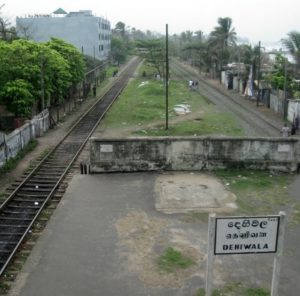 Dehiwela Station Road, as you can guess, ended at the railway station. My maternal grandfather often sent us coconuts and various other commodities by train. I used to go with my mother, establish our identity and lug the heavy sacks up two flights of stairs and down another two, to where the car was parked. The area where we parked the car, was also the Bus terminus for route numbers 118, 119 and, believe it or not, there was a route number. 118 1/2 ! That route I must admit, did not last long.
Dehiwela Station Road, as you can guess, ended at the railway station. My maternal grandfather often sent us coconuts and various other commodities by train. I used to go with my mother, establish our identity and lug the heavy sacks up two flights of stairs and down another two, to where the car was parked. The area where we parked the car, was also the Bus terminus for route numbers 118, 119 and, believe it or not, there was a route number. 118 1/2 ! That route I must admit, did not last long.
At this terminus, there was a long shed with a metal grill in front. This was where we queued up at the end of each month (without fail) to pay a nominal fee and buy our monthly bus-season ticket. To a schoolboy of that era, the season ticket was the most prized possession. We did not leave home without it. It gave us the freedom to travel all over the place without having to pay for our bus ride. Strictly speaking, it was only meant for two journeys per day. But the kind bus conductors very rarely marked the ticket. We even kept the season ticket inside a clear plastic sleeve to protect it from the elements.
Station Road was also home to the Dutch Reformed Church and the Presbyterian Girls’ School, next door. This was the church which my paternal grandmother attended each Sunday and the school was where she had taught as an Art Teacher, before marriage. Her hometown was Dehiwela. I used to accompany her to church on some Sundays and on special occasions. When the church celebrated its 75th year, she was an honoured guest as she was the longest standing member of its congregation at that time. Our whole family attended that service. Thanks to my Burgher grandmother, we Buddhists celebrated Christmas with equal zest as we did the Sinhala/Tamil New Year. We never had any identity crisis nor did we have any complex of who we are. It is this background that taught me to live/co-exist with all Sri Lankans, irrespective of the ethnicity, caste or their religious beliefs.
Exploring Dehiwela by bicycle
When I passed my Ordinary Level Examination, my father took me to Hunter & Co., in the Pettah and got me a brand new Raleigh Bicycle. I would have preferred the sports version but what I got was the standard version in black. But it did not matter. I was mobile and no longer had to double and ride as a pillion on a friend’s bike. My father got me a large-scale Survey Department map of Dehiwela. So, most weekends saw a motley crew of cyclists in various bikes (sports bikes, choppers and my standard bike) with an extra passenger each, exploring Dehiwela and its lesser known roads, lanes and by-ways. It was great fun. If we had a puncture, we pushed the bike to the nearest repair shop (“winkaley”) and got it repaired. Minor repairs were handled by us, ourselves. My bike had an air pump and a tool-kit as accessories, courtesy of the Raleigh & Co. Most of the places we explored were off the beaten path and others where we had never been too. We even extended our travels to the Ratmalana Airport. There were no security issues then. The only hazards were the learner drivers (L-board) nervously navigating the lonely road, trying to master the art of driving without killing pedestrians. We gave them an extra wide berth. A few years later, I too was taught the art of driving by my father in our Morris Minor, on that very same road! Right in front of the entrance to the airport building, was a large circular pond. This was where I (and countless others) was instructed on the ’round-about’ rules and etiquette. I have lost count of the number of times I have driven round and round that pond.
Not all of our explorations went off smoothly. Some got us into trouble but mostly, not of our making. Dogs were a menace. They would chase us trying to nip our ankles. Too many times we ended up in drains and ditches, trying to get away from them. On certain instances, irate and protective fathers set their domestic dogs up on us, thinking that we were after their precious daughters. Sometimes it was not too far from the truth. But, boys will always be boys. At the end of each expedition, I would faithfully mark the routes taken, on the map with a black Platignum pen.
Another ‘menace’ was the bored policeman whom we encountered on the road. If we were caught ‘doubling’ or without a licence, they would let out the air in the tyres after yelling at us. The licence was a rectangular piece of metal, which cost us .50cts and had to be purchased at the Municipality. The metal ‘badge’ had to be affixed in a prominent place on the bike – usually in the front-wheel sprocket. Most of the time we did didn’t have a valid licence.
We were also constantly making adjustments and improvements to our bikes. Somehow, the original manufacturers had never thought of them. I wonder why. One such ‘improvement’ was to remove the front brakes and install a bell. There was a small wheel attached to the brake mechanism and then the brake was applied, the bell rang loudly and consistently. It sounded more like a siren than a bell. For some reason, it seemed to annoy people. It never bothered us and we thought it was fun. Of course, tinkering with one’s bike can be hazardous to one’s health. Once, after tinkering with my bike, I did a ‘test-run’. All was fine until I started going down a hill. At that point, my front wheel decided to part company from me and went off, on its own. Net result: I ended up with many cuts and bruises.
The 70s and the bakery experience
The 1970s ‘self sufficient’ era ushered in new challenges for us. The country was going through a bad patch. My parents decided to grow food. So, after getting permission from the owner of the vacant land adjoining our house, we became the local version of ‘The Swiss Family Robinson’. We cleared the land, dug up the soil and planted. We planted beans, winged beans, sweet potatoes, manioc, carrots, salad leaves, okra, soya, mangoes and papaws. It was not quaint and romantic, and it was hard work. We had to remove weeds and water the plants, back breaking stuff. But this was the era of ration books, co-operative shops and rationed food. To the present generation who congregate at coffee bars, bistros, bars, clubs and night clubs, this may sound like tales from the twilight zone.
We had a bakery about 500m from our place. I used to go there early morning, around 5:30 AM to get our bread quota. I took with me a bag and our ‘bread book’. At that time, due to rationing, each household was allowed half-loaf of bread per person for the day. The Mudalali would give me the exact ration and note it on the bread-book. Even though we knew him personally it never crossed our minds to ask for more or circumvent the system. We followed the rules.
Later, when the restrictions were removed, I used to go to the bakery and watch the whole process and bring home ‘hot-hot’ bread. The entire bread making process was done in one location: bare-chested men kneading the dough, making small lumps and filling the metal moulds and finally pushing the trays laden with moulds into a large cavern-like oven. It was fuelled by large amounts of firewood which was stored on a side. The workers used large wooden paddles with long wooden handles to move the trays into the oven, move them around and finally take out the trays of baked bread. The Mudalali’s son was known to me (he was around my age). Therefore, on occasion, I was allowed to handle a paddle and move the trays about. I can tell you, it was a lot harder than it looked. I used to take out the oven-fresh bread from the mould, pay for it and take it home. To me, to this day, that is what ‘oven-fresh’ really means. They also produced other confectionary items such as maalu-paan, kimbula-bunis, ispungi-cake and gnanakatha. Later, the son took over, expanded the business, introduced a fleet of bread vans and now (I am told) his son has taken over.
Cockfighting, Thovil and other village pastimes
Back then, Dehiwela was almost a village. The canal was about 500m from where we lived and on the canal-banks (ela-kandiya) were lots and lots of shanties. Some structures were legal and many were not. The community there was a world by itself: some of the dwellers were among the survivors and victims of the tragedy that resulted in a mass funeral described earlier. I used to walk down and play with those kids. Some of them were seconded by my grandmother for ‘goma-detail’. They would search the neighbourhood for fresh and dried cow dung, put them in bags and deliver them to her. They were rewarded with a few rupees. The cow dung was her contribution to organic gardening. She had a true green-thumb.
A highly illegal but openly practiced pastime (the others being distilling hooch and card games) of the adult canal folk was cockfighting: a gruesome sport (for a want of a better word) which always ended with either a dead or mortally wounded cockerel. Whether it ended in a pot or given a decent burial, I never found out. I have watched a few fights with morbid fascination. In one instance, the atmosphere was so charged, that there was an argument which ended in a stabbing – though not fatal. Some of those who played with me from the ela-kandiya, ended up as village thugs, some ended up in jail and yet some, ended dead resulting from gang-fights. But not all took the same route. One night, someone knocked on our gate, in the night. It was a father, mother and their young son (much older to me). They were canal folk. They wanted my father’s help to get the son into the Navy. My father, who was still serving in the Navy, told them what procedures to follow and how to apply. That young boy joined the Navy on merit and became a very capable and respected sailor. He eventually retired after twenty years of service as a master-chief-petty-officer. I remember meeting him in the Navy establishment SLNS Elara, the navy’s base in Jaffna. He presented us with a set of painted faces – painted on dried Palmyra Seeds. On retirement he qualified and served on coastal services as Master.
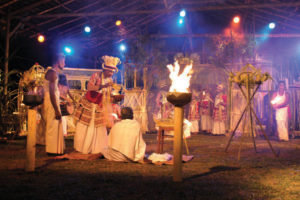 Dehiwela folk were great believers in the occult and the dark arts. Hooniyangs and thovil-madu were a dime a dozen. A gang of us, fellow morbid rubber necks, would attend some of the thovil-madu and watch the process. There was always a large crowd and no end of theories as to how the ‘patient’ came to be in his/her current predicament. It was riveting to see the kattadiya in action (the man was a motor-mouth) and as the finale grew close, the drums would get louder. Then the kattadiya’s gyrations grew faster and faster the crescendo rose higher and higher, the patient got restless and finally, a poor chicken parted with its head in the interests of the healing process.
Dehiwela folk were great believers in the occult and the dark arts. Hooniyangs and thovil-madu were a dime a dozen. A gang of us, fellow morbid rubber necks, would attend some of the thovil-madu and watch the process. There was always a large crowd and no end of theories as to how the ‘patient’ came to be in his/her current predicament. It was riveting to see the kattadiya in action (the man was a motor-mouth) and as the finale grew close, the drums would get louder. Then the kattadiya’s gyrations grew faster and faster the crescendo rose higher and higher, the patient got restless and finally, a poor chicken parted with its head in the interests of the healing process.
Once, while attending a birthday party of a friend who lived very close to my home, we ran out of music. So I volunteered to walk home and bring back some audio tapes of mine. No CDs or DVDs at that time. As I was about to leave, I popped a nice and tasty cutlet into my mouth (one for the road style). My host who witnessed it, quickly stopped me and insisted that I drink a glass of water before I left. I obliged but asked him why. His explanation was that I have to walk alone in the dark and there was an empty land next to my house and, in such places lurks the ‘devil’ which loves fried food. Who knew? Not me. My host was a Burgher, and all good Burghers believed in non-Christian voodoo. In Dehiwela, our beliefs transcended religion and ethnicity.
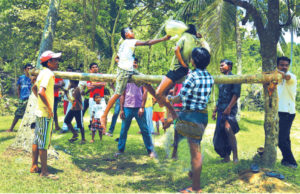 During the Sinhala-Tamil New Year, Dehiwela came alive. There were many ‘Avurudu Uthsawa’. As for a venue, any empty land was fair game and no one really complained. These were organised by different Sports Clubs and the such-like. So there were many willing hands to clear the land and put up the props needed for the games. There was always a stage, for presentations and for dignitaries to sit. They were served with biscuits and colourful drinks while the riff-raff, like us, looked on. Each “ulella” was not complete if there were no popular games like the greasy pole, kana-muttiya, eating buns (hanging on a string) and the kotta-pora. I believe many long-standing vendettas and private squabbles were settled during the kotta-pora. All such celebrations ended with the “Avurudu Kumari” contest. Not all were in agreement as to who should win. But it was interesting to listen to the comments of the on-lookers, about the beauty, the ugliness and the character of the participants. All in all, it was great entertainment – and educational too!.
During the Sinhala-Tamil New Year, Dehiwela came alive. There were many ‘Avurudu Uthsawa’. As for a venue, any empty land was fair game and no one really complained. These were organised by different Sports Clubs and the such-like. So there were many willing hands to clear the land and put up the props needed for the games. There was always a stage, for presentations and for dignitaries to sit. They were served with biscuits and colourful drinks while the riff-raff, like us, looked on. Each “ulella” was not complete if there were no popular games like the greasy pole, kana-muttiya, eating buns (hanging on a string) and the kotta-pora. I believe many long-standing vendettas and private squabbles were settled during the kotta-pora. All such celebrations ended with the “Avurudu Kumari” contest. Not all were in agreement as to who should win. But it was interesting to listen to the comments of the on-lookers, about the beauty, the ugliness and the character of the participants. All in all, it was great entertainment – and educational too!.
Gang wars were commonplace in Dehiwela. We heard of shootings, people being chopped up with home-made swords and acid throwing, almost daily. One day we were playing badminton on our lane, when a group of men walked past us. Each was carrying a home-made vicious looking sword. I do not know who got the chop, that day!
The Dehiwela Zoo & the Min-Madura
I cannot remember as to when it was opened to the public, but the opening of “Min-Madura” created quite a stir in the country. It was one of a kind and if I am not mistaken, the brainchild of the then Director of the Zoo, Dr. Lyn de Alwis. To say it was “state of the art” would be an understatement. Within a few days of the opening, we all queued (for hours) to enter Min-Madura. It had its own entrance. Sellers of sweets, toys and other items must have made a small fortune, during those days. Dehiwela was the cynosure of the entire country. People from all part of the country, rich and the poor stood patiently in the same queue to gain entry.
Upon entry, you were transformed into a different world. It was in a form of a tunnel, with subdued lighting and huge tanks on either side of the walk-way filled with all kinds of sea creatures. Some of the tanks on either side were connected and the fish swam from one tank to another, over your head. The last enclosure had many penguins, watching us. It was the first time we had seen them, outside books. And for the first time in Sri Lanka, Min-Madura has a “conveyor-belt” to carry you through your journey, if you did not want to walk. I have not seen that mode of conveyance in any public place in Sri Lanka, before or since. Several years later, Dr. de Alwis took over the Singapore Zoo and made it one of the best in Asia – or perhaps the best. Sadly, the Min-Madura slowly but surely ground to a halt (but, unlike “William Grinding”, with a whimper, not a bang). What masquerades as the Min-Madura today, is a far-cry from what it was, in its heyday.
While there are still a lot of visitors to the Zoo, I feel that its general standards, state (and welfare of its animals) and its professionalism has gone down rapidly. The Zoo that I remember, loved and spent countless hours at, was different and it was such a happy place. One day, I counted all the tour buses (parked on either side of Allen Avenue) from the bottom of the hill, up to Karagampitiya, while cycling. I counted 102. To me, that was some sort of a record. I do not think there are that many buses that arrive with visitors today.
The old Zoo had, what seemed to me a fancy (entrance) ticket dispenser. On the surface, it was a shiny stainless steel top with a few slots. When you paid your money for your ticket, the operator punched a few buttons and hey-presto, your ticket magically appeared from the relevant slot. At that time, you could buy a ticket for your vehicle and drive it to the car park. The road and walk-way areas were swept clean and there were refuse bins located all over the place. No one threw their rubbish on a side. Maybe my memory is getting selective, but I remember the cages being quite clean and had proper name boards describing each inmate with some general information. Even the trees were named. 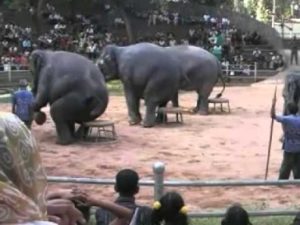 There was only one large restaurant, where a full meal could be had. It was located right across from where the elephants displayed their talents. It was the last activity of the Zoo before it was closed for the day and it was fondly referred to as the ‘ali dance’. There was a small picnic area where those who brought their own food could sit at tables and benches and have a meal in a relaxed manner. The Zoo also provided many water spouts for them. There were also elephant rides, where you could sit in a wicker gondola atop the elephant and take a short ride.
There was only one large restaurant, where a full meal could be had. It was located right across from where the elephants displayed their talents. It was the last activity of the Zoo before it was closed for the day and it was fondly referred to as the ‘ali dance’. There was a small picnic area where those who brought their own food could sit at tables and benches and have a meal in a relaxed manner. The Zoo also provided many water spouts for them. There were also elephant rides, where you could sit in a wicker gondola atop the elephant and take a short ride.
As members of the YZA, we had almost unrestricted access to the Zoo and also access to certain areas not accessible to the general public. This gave us a sort of demi-god complex. One place I loved to visiting was the Zoo hospital. Here we were able to get up close to exotic animals. There was this one lion cub (3 months old or so) which, for some reason, was not being accepted by the pride. So it lived inside the hospital for a long time. On weekends, it was dressed in a collar attached to a long and thick chain and given a walk in public with its keeper in attendance. As we were known to the zoo staff, we too were allowed to hold the chain and walk the cub. As it was quite tame, visitors were allowed to pet it. The looks of admiration by the visitors while we held the chain, I shall carry to my grave.
After the Zoo closed to the public for the day, it was feeding time and those of us in the YZA who lived within walking distance, often hung around to watch the feeding. Once, while inside the herpetarium with a schoolmate we saw a rattle snake getting ready for dinner. Its dinner was a large frog and the rattler took its time, knowing full well, that the frog had no place to go. It was almost slow-motion. It opened its mouth wide. The insides I remember clearly, was a lovely hue of salmon-pink. Its fangs were encased in a sheath of skin. Then slowly the sheath rolled back and the deadly fangs were exposed. Then, it struck the frog, emptying its venom. After the frog stopped twitching it, almost leisurely, swallowed it. I was standing just a few inches away, separated by a glass. I had goose bumps.
Another day, the same friend and I were watching a Polar Bear, after hours. This enclosure was a huge pit and the visitors viewing area was many feet higher with high wall. Between this wall and where the bear was, stood a large pool. It was for the animal to swim (and cool off) and also act as a sort of moat. The polar bear must have been having a particularly bad day. It decided it did not want two inquisitive boys ogling him. It took a running jump and lunged at us. Its outstretched paws hit the wall, about four feet below the top of the wall and fell into the moat with a splash. I have no idea what happened next. I had broken Usain Bolt’s record, many years before he was born!
A few years ago, I took some German friends of mine to the Zoo and Min-Madura. It was sad to see the state both had fallen into. The cages were not clean, the animals looked tired and unhealthy, the smell was unbearable and there was litter everywhere. Lunch packets left all over. Crows pecking at them, plastic bags blowing in the wind, etc. It was indeed, very sad. I have not visited the Zoo, since.
The Municipal Library and the Cosmopolitan Tennis Club
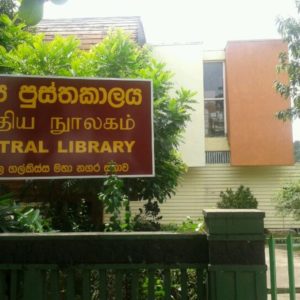 The municipal library was found at the very end of Frazer Avenue. It was housed in an airy and well maintained two-storey building. I have spent countless hours browsing and reading its well stocked shelves. I am not sure how they found the necessary funds. But it was a treasure trove for us. The ground floor catered to children (with colourful book-shelves, colourful chairs and tables. It also housed the entire series of Tintin and Asterix comics. They also had the entire series of Hardy Boys, Sudden (a cowboy series), Biggles, Enid Blyton, Nancy Drew, etc. They also had Beno and Buster Annuals. You could sit there and read or borrow them. There was another section which had the daily newspapers of all three languages. In a typical public library style, the newspapers were anchored to the table with a broad (and heavy) metal band and locked into place. This was to discourage people from taking away the newspapers.
The municipal library was found at the very end of Frazer Avenue. It was housed in an airy and well maintained two-storey building. I have spent countless hours browsing and reading its well stocked shelves. I am not sure how they found the necessary funds. But it was a treasure trove for us. The ground floor catered to children (with colourful book-shelves, colourful chairs and tables. It also housed the entire series of Tintin and Asterix comics. They also had the entire series of Hardy Boys, Sudden (a cowboy series), Biggles, Enid Blyton, Nancy Drew, etc. They also had Beno and Buster Annuals. You could sit there and read or borrow them. There was another section which had the daily newspapers of all three languages. In a typical public library style, the newspapers were anchored to the table with a broad (and heavy) metal band and locked into place. This was to discourage people from taking away the newspapers.
The upstairs section was the adult’s area. There were rows and rows of book cases laden with all types of books – journals, fiction & non-fiction. I borrowed and read the entire Perry Mason series, most of the James Hadley Chase, Jack Higgins, Clive Cussller John Le Carre books, thanks to this wonderful establishment. I am ever grateful to those councillors who voted much needed public funds to feed my voracious reading appetite and for widening my horizons. As a school leaver, studying for my I T Diploma, I found many of the reference books which I could not find elsewhere or was too expensive to buy, at this wonderful library.
Right next to the library, was the Cosmopolitan Tennis Club. It had many tennis courts and in the evenings, saw players of both genders enjoying a game of tennis. Although I was not a member, I have played there on several occasions, thanks to a classmate, who was a member. I believe, both establishments, still exists.
At the top of Frazer Avenue there was the Petrol Shed. This was our ‘shed’ where we had an account and where I would take the family car for its regular service. It was an old fashioned establishment. Sometimes I would wait until the whole process was completed. On other times, I would walk down to the library and browse until the service was done. When we decided to sell our trusty Morris Minor, it was the owner of this establishment who bought it. He knew how well we looked after it and only got it serviced by him.
People’s Park and the Carter’s Rest
As kids (more like urchins) we played football and cricket on the road. As we grew older, and got sick of our tennis balls being confiscated by irate house owners on either side of the road, we moved our ‘pitch’ to People’s Park. Today, it is referred to by the fancy name, S de S Jayasinghe Stadium. I am told that it has a beautifully maintained grassy ground. Back then, its surface was entirely gravel (boralu) and not a blade of grass insight. At any given time on week-ends, there were several cricket matches or football matches being played simultaneously. Sometimes, it was a mix of both ! Somehow, we never had any fights or disagreements. Nor any confusions as to whose ball it was. I guess the training we got from playing ‘interval cricket in school’ gave us the necessary experience.
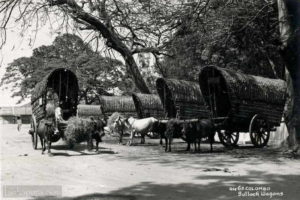 At the ‘thunmang handiya’ where Atapattu Mawatha joined Allen Avenue, there is a wild bo-tree. It was there even when we moved into Dehiwela. Sometimes, the Municipality stored excess building material under it but it was, probably, the last of the bullock-cart overnight resting places, the harak gaala. We used to have a regular train of bullock carts visiting the area and they used the area under this tree, as their rest stop. Each train, consisted of about five to six carts. They were always transporting woven coconut leaf (cadjan) used for roofing.
At the ‘thunmang handiya’ where Atapattu Mawatha joined Allen Avenue, there is a wild bo-tree. It was there even when we moved into Dehiwela. Sometimes, the Municipality stored excess building material under it but it was, probably, the last of the bullock-cart overnight resting places, the harak gaala. We used to have a regular train of bullock carts visiting the area and they used the area under this tree, as their rest stop. Each train, consisted of about five to six carts. They were always transporting woven coconut leaf (cadjan) used for roofing.
I never knew if they were being transported to buyers in Dehiwela or whether they were simply passing through. They were a true ‘ harak gaala’. At dusk, they would arrange the carts in a semi-circle and unhitch the bullocks and feed them. Then they would build a campfire and cook their meals and eat. They almost always had a dog or two, who were also fed. I have seen these dogs sleeping, hammock style, inside the hanging gunny bags underneath each cart. This scene always reminded me of C T Fernando’s song – “Barabage, barabage…….. ‘raala da goni padanguwey inne …..’.”
In the morning, the carters religiously swept the area, burnt their rubbish and left. There was never a hint that they had ever been there. What a lesson they could teach the present generation.
Today, someone has built a permanent (cement) fence around the tree, built a shrine with a statue etc. The carters are no more. But it seems the wild bo-tree has been upgraded to a holy tree. And taxis and lorries are parked around it at night.
Everlasting Friendships
The boys with whom I grew up in Dehiwela were, a mixed bunch. We were of different religions, different ethnicities, different beliefs and different social levels. None of these ever mattered to us. We never thought we were different to one another. The only time it did matter was during different festivals when we congregated at each other’s houses to partake in various delicacies. Even though we have grown up and gone our different ways, the ‘Dehiwela Boys of the 70s’ are very much in touch, despite some living overseas. Those friendships are etched in stone and will stand the test of time. I am eternally grateful to them and their families who taught me the true meaning of lifelong friendships and to rise above petty and shallow thinking, which sadly, has enslaved the present generations.
Alas, the Dehiwela in which I grew up, is no more. And with it, – like ‘William Grinding’ – an essential part of my childhood.
(The writer is as an IT consultant based in Colombo. You may contact him at nalakadevendra@gmail.com)
